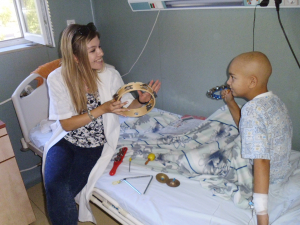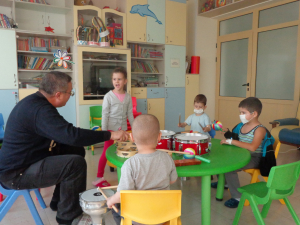
ARTON PROGRAM - The therapeutic power of the group
Creative projects involving group work - general musical performance or group painting, collage, sculpture - are useful in helping to explore and strengthen social...
Peer pressure and TV commercials for junk food can make getting your children to eat well an uphill struggle. Factor in your own hectic schedule and it’s no wonder so many kids’ diets are built around convenience and takeout food. But switching to a healthy diet can have a profound effect on your child’s health, helping them to maintain a healthy weight, stabilize their moods, sharpen their minds, and avoid a variety of health problems. A healthy diet can also have a profound effect on your child’s sense of mental and emotional wellbeing, helping to prevent conditions such as depression, anxiety, bipolar disorder, schizophrenia, and ADHD.
Eating well supports your child’s healthy growth and development into adulthood and may even play a role in lowering their risk of suicide. If your child has already been diagnosed with a mental health problem, a healthy diet can help them to manage the symptoms and regain control of their health.
It’s important to remember that your kids aren’t born with a craving for French fries and pizza and an aversion to broccoli and carrots. This conditioning happens over time as they’re exposed to more and more unhealthy food choices. However, it is possible to reprogram your children’s food preferences so that they crave healthier foods instead.
The sooner you introduce wholesome, nutritious choices into a child’s diet, the easier they’ll be able to develop a healthy relationship with food that can last them a lifetime. And it can be simpler and less time-consuming than you imagine. With these tips, you can instill healthy eating habits without turning mealtimes into a war zone and give your kids the best opportunity to grow into healthy, well-balanced adults.
Whether they’re toddlers or in their teens, children develop a natural preference for the foods they enjoy the most. To encourage healthy eating habits, the challenge is to make nutritious choices appealing.
Focus on overall diet rather than specific foods. Kids should be eating more whole, minimally processed food—food that is as close to its natural form as possible—and less packaged and processed food.
Be a role model. The childhood impulse to imitate is strong so don’t ask your child to eat vegetables while you gorge on potato chips.
Disguise the taste of healthier foods. Add vegetables to a beef stew, for example, or mash carrots up with mashed potato, or add a sweet dip to slices of apple.
Cook more meals at home. Restaurant and takeout meals have more added sugar and unhealthy fat so cooking at home can have a huge impact on your kids’ health. If you make large batches, cooking just a few times can be enough to feed your family for the whole week.
Get kids involved in shopping for groceries and preparing meals. You can teach them about different foods and how to read food labels.
Make healthy snacks available. Keep plenty of fruit, vegetables, and healthy beverages (water, milk, pure fruit juice) on hand so kids avoid unhealthy snacks like soda, chips, and cookies.
Limit portion sizes. Don’t insist your child cleans the plate, and never use food as a reward or bribe.
Kids who enjoy breakfast every day have better memories, more stable moods and energy, and score higher on tests. Eating a breakfast high in quality protein—from enriched cereal, yoghurt, milk, cheese, eggs, meat, or fish—can even help teenagers lose weight.
Making time to sit down as a family to eat a home-cooked meal not only sets a great example for kids about the importance of healthy food, it can bring a family together—even moody teenagers love to eat tasty, home-cooked meals!
Regular family meals provide comfort. Knowing the whole family will sit down to eat dinner (or breakfast) together at approximately the same time every day can be very comforting for kids and enhance appetite.
Family meals offer opportunity to catch up on your kids’ daily lives. Gathering the family around a table for a meal is an ideal opportunity to talk and listen to your kids without the distraction of TV, phones, or computers.
Social interaction is vital for your child. The simple act of talking to a parent over the dinner table about how they feel can play a big role in relieving stress and boosting your child’s mood and self-esteem. And it gives you chance to identify problems in your child’s life and deal with them early.
Mealtimes enable you to “teach by example.” Eating together lets your kids see you eating healthy food while keeping your portions in check and limiting junk food. Refrain from obsessive calorie counting or commenting on your own weight, though, so that your kids don’t adopt negative associations with food.
Mealtimes let you monitor your kids’ eating habits. This can be important for older kids and teens who spend a lot of time eating at school or friends’ houses. If your teen’s choices are less than ideal, the best way to make changes is to emphasize short-term consequences of a poor diet, such as physical appearance or athletic ability. These are more important to teens than long-term health. For example, “Calcium will help you grow taller,” or, “Iron will help you do better on tests.”
Simple or refined carbohydrates are sugars and refined grains that have been stripped of all bran, fiber, and nutrients—such as white bread, pizza dough, pasta, pastries, white flour, white rice, and many breakfast cereals. They cause dangerous spikes in blood sugar and fluctuations in mood and energy. Complex carbs, on the other hand, are usually high in nutrients and fiber and are digested slowly, providing longer-lasting energy. They include whole wheat or multigrain bread, high-fiber cereals, brown rice, beans, nuts, fruit, and non-starchy vegetables.
A child’s body gets all the sugar it needs from that naturally occurring in food. Added sugar just means a lot of empty calories that contribute to hyperactivity, mood disorders, and increase the risk for obesity, type 2 diabetes, and even suicidal behaviors in teenagers.
The American Heart Association recommends that sugar intake for children is limited to 3 teaspoons (12 grams) a day. A 12-ounce soda contains up to 10 teaspoons or 40g of added sugar, shakes and sweetened coffee drinks even more. Large amounts of added sugar can also be hidden in foods such as bread, canned soups and vegetables, frozen dinners, and fast food. In fact, about 75% of packaged food in the U.S. contains added sugar.
Don’t ban sweets entirely. Having a no sweets rule is an invitation for cravings and overindulging when given the chance.
Give recipes a makeover. Many recipes taste just as good with less sugar.
Avoid sugary drinks. Instead, try adding a splash of fruit juice to sparkling water or blending whole milk with a banana or berries for a delicious smoothie.
Create your own popsicles and frozen treats. Freeze 100% fruit juice in an ice-cube tray with plastic spoons as popsicle handles. Or make frozen fruit kabobs using pineapple chunks, bananas, grapes, and berries.
Avoid foods that impair your child’s mood
Fast food is typically high in sugar, unhealthy fat, and calories and low in nutrients. Still, junk food is tempting for kids, so instead of eliminating it entirely, try to cut back on the times your kids eat fast food and, on the times that they do, make the healthiest choices possible.
Kid-friendly junk food alternatives
Instead of… Try…
French fries “Baked fries” grilled in the oven and salted lightly
Ice cream Yogurt; sorbet; fresh fruit smoothies
Fried chicken Baked or grilled chicken
Doughnuts or pastries Bagels; English muffins; home baked goods with less sugar
Chocolate-chip cookies Graham crackers, fig bars, vanilla wafers, fruit and caramel dip
Potato chips Baked vegetable chips or, for older children, nuts
Skip the fries. Instead, take along a bag of mini carrots, grapes, or other fruits and vegetables.
Watch portion size. Stick to the children’s menu or go for the smallest size. Order pizza by the slice—it will satisfy your child’s craving without tempting overindulgence.
Order the kid’s meal with substitutions. Children often love the kid’s meal more for the toys than the food. Ask to substitute healthier choices for the soda and fries.
Opt for chicken and vegetables in a sit-down restaurant, rather than a big plate of macaroni and cheese.
Be wise about sides. Sides that can quickly send calories soaring include fries, chips, rice, noodles, onion rings, and biscuits. Better bets are grilled vegetables, side salads, baked potato, corn on the cob, or apple slices.
Kids need healthy fats—and plenty of them—in their diet. Healthy fat helps kids fill up (and stay full), concentrate better, and improves their mood.
Monounsaturated fats, from olive oil, avocados, nuts (like almonds, hazelnuts, and pecans), and seeds (such as pumpkin, sesame).
Polyunsaturated fats, including Omega-3 fatty acids, found in fatty fish, such as salmon, herring, mackerel, anchovies, and sardines, or in flaxseed and walnuts.
Trans fats, are found in vegetable shortenings, some margarines, crackers, candies, cookies, snack foods, fried foods, baked goods, and other processed foods made with “partially hydrogenated” vegetable oils (even if they claim to be trans-fat-free). No amount of trans fat is safe.
Encourage picky eaters to enjoy a wider variety of foods
Picky eaters are going through a normal developmental stage. Just as it takes numerous repetitions for advertising to convince an adult consumer to buy, it takes most children 8-10 presentations of a new food before they will openly accept it.
Instead of simply insisting your child eat a new food:
Whether picky eaters or not, kids don’t always want what’s healthy for them—especially fruit and vegetables. But there are ways to make them more enticing.
The first step is to limit access to unhealthy sweets and salty snacks. It’s much easier to convince your child that an apple with peanut butter is a treat if there are no cookies available. Here are some more tips for adding more fruits and veggies to your child’s diet:
Let your kids pick the produce. It can be fun for kids to see all the different kinds of fruits and veggies available, and to pick our new ones or old favorites to try.
Sneak vegetables into other foods. Add grated or shredded veggies to stews and sauces to make them blend in. Make cauliflower “mac” and cheese. Or bake some zucchini bread or carrot muffins.
Keep lots of fresh fruit and veggie snacks on hand. Make sure they’re already washed, cut up, and ready to go. Add yogurt, nut butter, or hummus for extra protein.
Genetically Modified Organisms (GMOs) are mainly engineered to make food crops resistant to herbicides or to produce an insecticide. Since children’s brains and bodies are still developing, they are more sensitive to these toxins. Eating organic produce has been shown to reduce pesticide levels in kids, but tends to be more expensive. So how can you keep your children safe if you’re on a budget?
Children who are substantially overweight are at greater risk for cardiovascular disease, bone and joint problems, sleep apnea, poor self-esteem, and long-term health problems in adulthood.
Addressing weight problems in children requires a coordinated plan of physical activity and healthy nutrition.
The goal is to slow or halt weight gain (unless directed by your child’s doctor), thereby allowing your child to grow into their ideal weight.
Don’t fall into the low-fat trap. Because fat is so dense in calories, a little can go a long way in making kids feel full and keeping them feeling fuller for longer.
Eating a breakfast high in quality protein—from enriched cereal, yoghurt, milk, cheese, eggs, meat, or fish—can help overweight teenagers eat fewer calories throughout the rest of the day.
The benefits of lifelong exercise are abundant and regular exercise can even help motivate your kids to make healthy food choices.
Authors: Jeanne Segal Ph.D. and Lawrence Robinson

Creative projects involving group work - general musical performance or group painting, collage, sculpture - are useful in helping to explore and strengthen social...

In the ARTON Program our team of oncopsychologists, art therapists and music therapists develops the process of children's creativity as a process of...

In ARTON sessions, creating a piece of music or a song is an emotional experience of coping and satisfaction for the participating children. They make friends with...

Painting provides patients with a spontaneous, plastic method of depicting thoughts and experiences. Painting with paints is not as structured as with pencil or...










